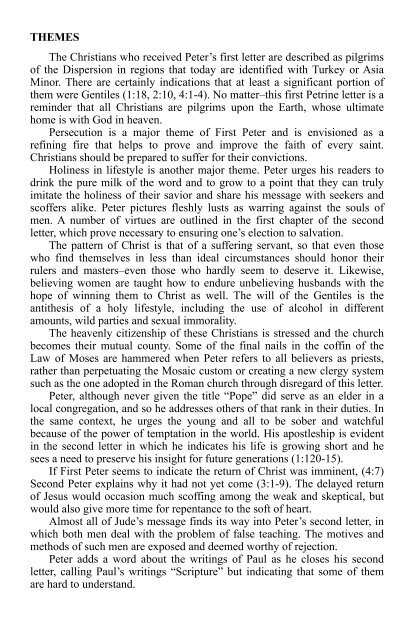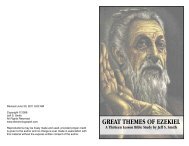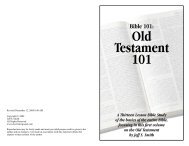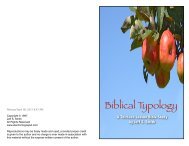New Testament Study Guides - ElectronicGospel
New Testament Study Guides - ElectronicGospel
New Testament Study Guides - ElectronicGospel
Create successful ePaper yourself
Turn your PDF publications into a flip-book with our unique Google optimized e-Paper software.
THEMES<br />
The Christians who received Peter’s first letter are described as pilgrims<br />
of the Dispersion in regions that today are identified with Turkey or Asia<br />
Minor. There are certainly indications that at least a significant portion of<br />
them were Gentiles (1:18, 2:10, 4:1-4). No matter–this first Petrine letter is a<br />
reminder that all Christians are pilgrims upon the Earth, whose ultimate<br />
home is with God in heaven.<br />
Persecution is a major theme of First Peter and is envisioned as a<br />
refining fire that helps to prove and improve the faith of every saint.<br />
Christians should be prepared to suffer for their convictions.<br />
Holiness in lifestyle is another major theme. Peter urges his readers to<br />
drink the pure milk of the word and to grow to a point that they can truly<br />
imitate the holiness of their savior and share his message with seekers and<br />
scoffers alike. Peter pictures fleshly lusts as warring against the souls of<br />
men. A number of virtues are outlined in the first chapter of the second<br />
letter, which prove necessary to ensuring one’s election to salvation.<br />
The pattern of Christ is that of a suffering servant, so that even those<br />
who find themselves in less than ideal circumstances should honor their<br />
rulers and masters–even those who hardly seem to deserve it. Likewise,<br />
believing women are taught how to endure unbelieving husbands with the<br />
hope of winning them to Christ as well. The will of the Gentiles is the<br />
antithesis of a holy lifestyle, including the use of alcohol in different<br />
amounts, wild parties and sexual immorality.<br />
The heavenly citizenship of these Christians is stressed and the church<br />
becomes their mutual county. Some of the final nails in the coffin of the<br />
Law of Moses are hammered when Peter refers to all believers as priests,<br />
rather than perpetuating the Mosaic custom or creating a new clergy system<br />
such as the one adopted in the Roman church through disregard of this letter.<br />
Peter, although never given the title “Pope” did serve as an elder in a<br />
local congregation, and so he addresses others of that rank in their duties. In<br />
the same context, he urges the young and all to be sober and watchful<br />
because of the power of temptation in the world. His apostleship is evident<br />
in the second letter in which he indicates his life is growing short and he<br />
sees a need to preserve his insight for future generations (1:120-15).<br />
If First Peter seems to indicate the return of Christ was imminent, (4:7)<br />
Second Peter explains why it had not yet come (3:1-9). The delayed return<br />
of Jesus would occasion much scoffing among the weak and skeptical, but<br />
would also give more time for repentance to the soft of heart.<br />
Almost all of Jude’s message finds its way into Peter’s second letter, in<br />
which both men deal with the problem of false teaching. The motives and<br />
methods of such men are exposed and deemed worthy of rejection.<br />
Peter adds a word about the writings of Paul as he closes his second<br />
letter, calling Paul’s writings “Scripture” but indicating that some of them<br />
are hard to understand.









